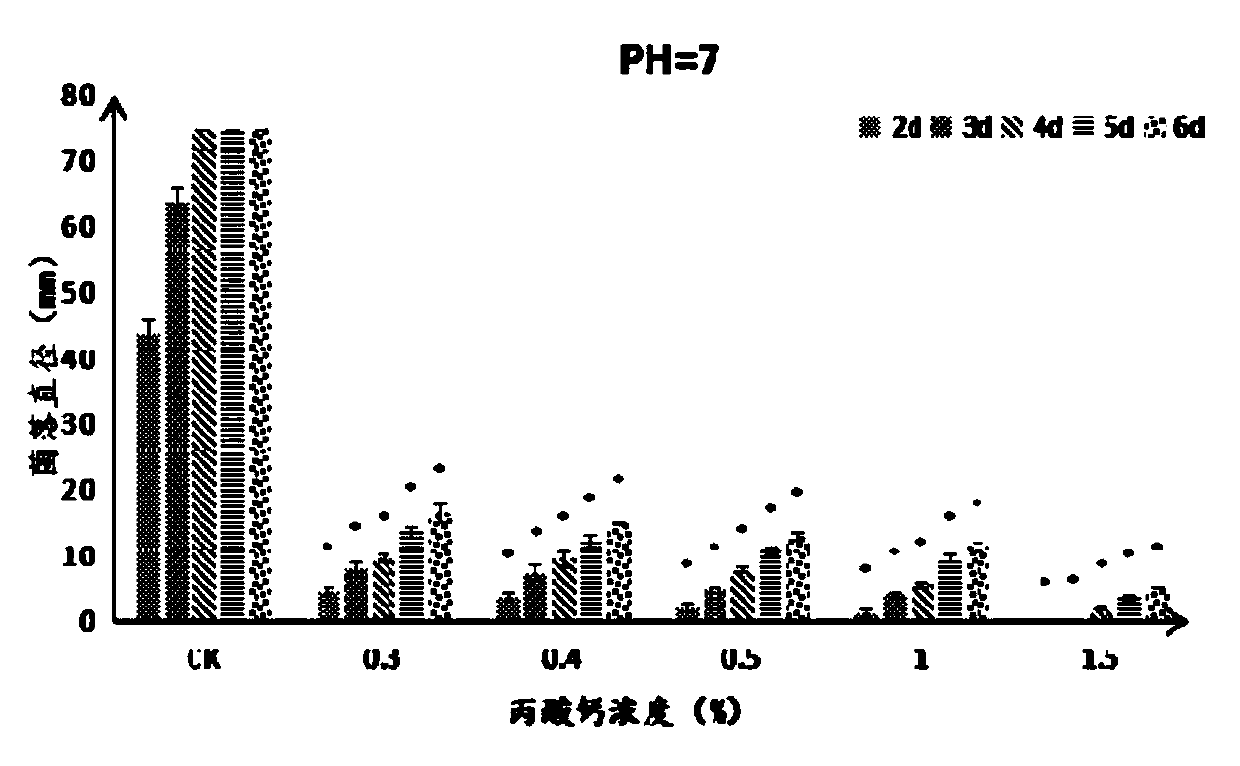Method for controlling postharvest diseases of grapes and preservative
A preservative and grape technology, applied in pest control, fruit and vegetable preservation, botanical equipment and methods, etc., can solve problems such as threats to food safety, poor drug resistance, large pollution, etc., and achieve simple preparation process and long action period , the effect of reducing the incidence of
- Summary
- Abstract
- Description
- Claims
- Application Information
AI Technical Summary
Problems solved by technology
Method used
Image
Examples
Embodiment 1
[0038] Embodiment 1: the influence of different concentrations and different pH value calcium propionate treatment on Botrytis cinerea mycelium growth
[0039] 1. Materials and methods
[0040] 1. Calcium propionate
[0041] Calcium propionate is a finished product purchased by Shanghai Macklin Biochemical Technology Co., Ltd., with a purity of ≥99.5% (analytical grade, AR).
[0042] Preparation of 10% mother liquor of calcium propionate at various pH values:
[0043] pH=5 calcium propionate mother liquor: add 12g calcium propionate to 113ml of distilled water, add 7ml of 1mol / L HCl solution to make 10% mother liquor, calibrate with pH test paper, filter and sterilize and store at 4°C for later use.
[0044] pH=6 calcium propionate mother liquor: Weigh 10g of calcium propionate into 100ml of distilled water, add 2-4ml of 1mol / l Hcl solution to adjust the pH value, use pH test paper to calibrate, filter and sterilize and store at 4°C for later use.
[0045] Conventional calc...
Embodiment 2
[0067] Example 2: Inhibitory effect of low pH value novel antiseptic preservative treatment on various plant pathogenic bacteria
[0068] 1. Materials and methods
[0069] Botrytis cinerea, Alternaria alternata, Colletotrichum gloeosporioides, and Fusarium graminearum are common pathogenic fungi isolated from grape fruits in the laboratory of our research group .
[0070] Use the 10% (w / v) calcium propionate mother liquor (pH value 5) prepared in Example 1 and the culture medium to be formulated into calcium propionate mass percent and be respectively 0,0.1%, 0.2%, 0.4%, pH value Both are medium of 5.
[0071] Others, such as the medium PDA used, the preparation method, the strain activation method, and the determination of the inhibitory effect of the new antiseptic preservative, etc., are as described in the "Materials and Methods" section of Example 1.
[0072] 2. Measurement results
[0073] The result is as Figure 2a , Figure 2b , Figure 2c , Figure 2d As show...
Embodiment 3
[0074] Embodiment 3: Containing the effect of calcium propionate novel antiseptic preservative to control botrytis cinerea disease
[0075] 1. Materials and methods
[0076] Fruit: Sunshine rose grape (Vitis vinifera L. Muscat-shine) was used as the experimental material. The fruit comes from Shanghai Malu Grape Research Institute. The fruits were immediately transported to the School of Life Sciences of East China Normal University after harvesting.
[0077]Pathogen: Botrytis cinerea (B.cinerea) spore suspension concentration is 1x10 5 (spores / ml).
[0078] Treatment method: Each grape fruit is inoculated with 20ul of the following treatment solution after being stabbed: A, a new antiseptic preservative containing 0.5% calcium propionate by mass percentage; B, a new antiseptic preservative containing 1% calcium propionate by mass percentage C, a novel antiseptic preservative containing 1.5% calcium propionate by mass percentage; D, distilled water (CK) (the inoculum size ...
PUM
 Login to View More
Login to View More Abstract
Description
Claims
Application Information
 Login to View More
Login to View More - R&D
- Intellectual Property
- Life Sciences
- Materials
- Tech Scout
- Unparalleled Data Quality
- Higher Quality Content
- 60% Fewer Hallucinations
Browse by: Latest US Patents, China's latest patents, Technical Efficacy Thesaurus, Application Domain, Technology Topic, Popular Technical Reports.
© 2025 PatSnap. All rights reserved.Legal|Privacy policy|Modern Slavery Act Transparency Statement|Sitemap|About US| Contact US: help@patsnap.com



